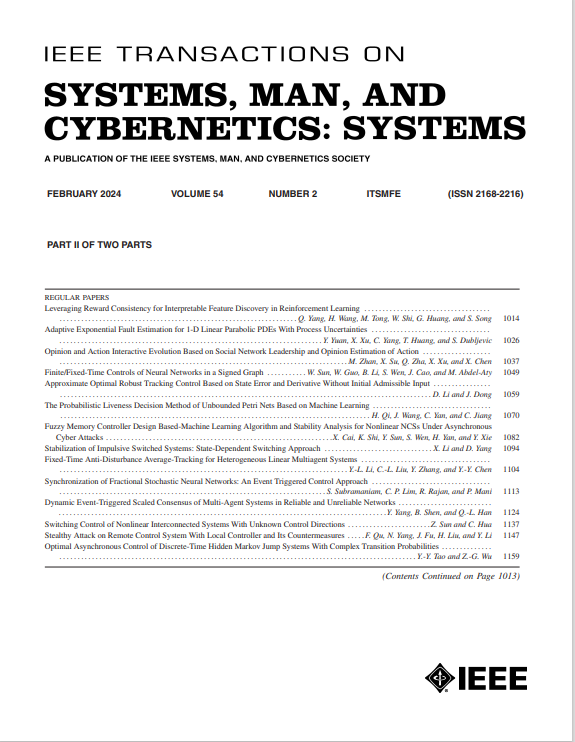基于多类型手术目标和约束的机器人柔性内窥镜加速抗噪声自适应神经网络
IF 8.6
1区 计算机科学
Q1 AUTOMATION & CONTROL SYSTEMS
IEEE Transactions on Systems Man Cybernetics-Systems
Pub Date : 2024-11-22
DOI:10.1109/TSMC.2024.3492324
引用次数: 0
摘要
在微创手术(MIS)中,视场(FOV)控制是至关重要的。自主内窥镜机器人已经开发出来,通过实现自主手术目标跟踪来促进MIS程序,从而减少外科医生的工作量。然而,现有的基于视觉伺服的自主内窥镜目标跟踪方法往往忽略了受限工作空间条件下的不安全性。例如,内窥镜机器人的尖端与患者的胸部或腹壁之间的碰撞会对患者组织造成风险,而内窥镜轴的广泛运动可能会损伤切口口组织。针对这些安全问题,本文提出了一种基于虚拟夹具的受限工作空间约束(RWSC)的新方法来重建内窥镜机器人的运动范围。采用二次规划(QP)优化框架控制机器人的运动,保证机器人在遵守RWSCs的前提下自主跟踪目标。为了解决QP问题,我们提出了一种具有新设计的激活函数(AF)的自适应归零神经网络(ZNN)。这种AF增强了ZNN具有预定义的时间收敛和噪声抑制能力,使其特别适用于时间敏感和容易产生噪声的手术应用。理论分析和实验结果表明,自适应ZNN比现有的基于神经网络动态的QP求解器收敛时间更短。物理验证表明所提出的RWSCs在限制内窥镜机器人工作空间方面的有效性,而视场控制策略使柔性内窥镜能够在各种约束和目标下自主跟踪目标。本文章由计算机程序翻译,如有差异,请以英文原文为准。
An Accelerated Anti-Noise Adaptive Neural Network for Robotic Flexible Endoscope With Multitype Surgical Objectives and Constraints
In minimally invasive surgery (MIS), the field of view (FOV) control is crucial. Autonomous endoscope robots have been developed to facilitate MIS procedures by enabling autonomous surgical target tracking, thus reducing the workload on surgeons. However, existing visual servoing-based target tracking methods for autonomous endoscopes often overlook the insecurity stemming from restricted workspace conditions. Instances, such as collisions between the endoscope robot’s tip and the patient’s chest or abdominal wall pose risks to patient tissue, while extensive motion of the endoscope shaft may damage incision port tissue. Addressing these security concerns, this article proposes a novel approach called virtual fixture-based restricted workspace constraint (RWSC) to reconstruct the endoscope robot’s movement range. A quadratic programming (QP) optimization framework is employed to govern the robot’s motion, ensuring autonomous target tracking while adhering to RWSCs. To solve the QP problem, we propose an adaptive zeroing neural network (ZNN) featuring a newly designed activation function (AF). This AF enhances the ZNN with predefined-time convergence and noise rejection capabilities, making it especially suitable for time-sensitive and noise-prone surgical applications. Theoretical analysis and experimental results demonstrate that our adaptive ZNN achieves shorter convergence times than existing neural dynamic-based QP solvers. Physical validations show the efficacy of the proposed RWSCs in limiting the workspace of the endoscope robot, while the FOV control strategy enables autonomous target tracking of flexible endoscopes under diverse constraints and objectives.
求助全文
通过发布文献求助,成功后即可免费获取论文全文。
去求助
来源期刊

IEEE Transactions on Systems Man Cybernetics-Systems
AUTOMATION & CONTROL SYSTEMS-COMPUTER SCIENCE, CYBERNETICS
CiteScore
18.50
自引率
11.50%
发文量
812
审稿时长
6 months
期刊介绍:
The IEEE Transactions on Systems, Man, and Cybernetics: Systems encompasses the fields of systems engineering, covering issue formulation, analysis, and modeling throughout the systems engineering lifecycle phases. It addresses decision-making, issue interpretation, systems management, processes, and various methods such as optimization, modeling, and simulation in the development and deployment of large systems.
 求助内容:
求助内容: 应助结果提醒方式:
应助结果提醒方式:


